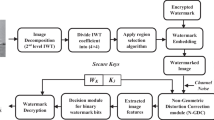Abstract
In digital images, visible watermarks are embedded to convey the ownership information directly to the world so that copyright violations can be prevented. The removable visible watermarking (RVW) techniques allow the authorized user to remove the watermark from the watermarked image and restore the host image with permissible loss. Usually the visibility of the watermark can’t be increased or decreased based on the application requirement. In most of the commercial communication, JPEG images are used over the internet because of its reduced size. In this paper a RVW scheme is proposed for JPEG images which allows the user to embed watermark in the host image with variable visibility levels. In this scheme, the watermark embedding is performed by modifying the frequency coefficients of host image during forward Discrete Cosine Transform phase of JPEG compression. Inverse operation is performed to remove the watermark and to recover the host image. Watermark key is used to enhance the security of watermarking scheme. Quality metrics of visible watermarking technique are confirmed through experiments.







Similar content being viewed by others
References
Sarkar, A., Madhow, U., & Manjunath, B. S. (2010). Matrix embedding with pseudorandom coefficient selection and error correction for robust and secure steganography. IEEE Transaction on Information Forensics and Security, 5(2), 225–239.
Hong, W., & Chen, T. S. (2012). A novel data embedding method using adaptive pixel pair matching. IEEE Transactions on Information Forensic and Security, 7(1), 176–184.
Tsai, M. J., Liu, J., Yin, J. S., & Yuadi, I. (2014). A visible wavelet watermarking technique based on exploiting the contrast sensitivity function and noise reduction of human vision system. Multimedia Tools and Applications, 72, 1311–1340.
Guo, L., Ni, J., & Shi, Y. Q. (2014). Uniform embedding for efficient JPEG steganography. IEEE Transactions on Information Forensics and Security, 9(5), 814–825.
Zong, T., Xiang, Y., Natgunanathan, I., Guo, S., Zhou, W., & Beliakov, G. (2015). Robust histogram shape-based method for image watermarking. IEEE Transaction on Circuits and Systems for Video Technology, 25(5), 717–729.
Agarwal, H., Sen, D., Raman, B., & Kankanhalli, M. (2016). Visible watermarking based on importance and just noticeable distortion of image regions. Multimedia Tools and Applications, 75, 7605–7629.
Taha, T. B., Ngadiran, R., & Ehkan, P. (2018). Adaptive image watermarking algorithm based on an efficient perceptual mapping model. IEEE Access, 6, 66254–66267.
Noor, R., Khan, A., & Sarfaraz, A. (2019). High performance and energy efficient image watermarking for video using a mobile device. Wireless Personal Communications, 104, 1535–1551.
Hu, Y., Lee, H. K., & Li, J. (2009). DE- based reversible data hiding with improved overflow location map. IEEE Transaction on Circuits and Systems for Video Technology, 19(2), 250–260.
Lee, C. F., Chen, H. L., & Tso, H. K. (2010). Embedding capacity raising in reversible data hiding based on prediction of difference expansion. Journal of Systems and Software, 83, 1864–1872.
Leung, H. Y., Cheng, L. M., Liu, F., & Fu, Q. K. (2013). Adaptive reversible data hiding based on block median preservation and modification of prediction errors. Journal of Systems and Software, 86, 2204–2219.
Qiu, Y., Qian, Z., & Yu, L. (2016). Adaptive reversible data hiding by extending the generalized integer transformation. IEEE Signal Processing Letters, 23(1), 130–134.
Huang, F., Qu, X., Kim, H. J., & Huang, J. (2016). Reversible data hiding in JPEG images. IEEE Transaction on Circuits and Systems for Video Technology, 26(9), 1610–1621.
Brabin, D. R. D., Perinbam, J. R. P., & Meganathan, D. (2017). A block based reversible data hiding scheme for digital images using optimal value computation. Wireless Personal Communications, 94(4), 2583–2596.
Xie, X., Lin, C., & Chang, C. (2019). A reversible data hiding scheme for JPEG images by doubling small quantized AC coefficients. Multimedia Tools and Applications, 78, 11443–11462.
Yang, Y., Sun, X., Yang, H., Li, C. T., & Xiao, R. (2009). A contrast-sensitive reversible visible image watermarking technique. IEEE Transactions on Circuits and Systems for Video Technology, 19(5), 656–667.
Tsai, H. M., & Chang, L. W. (2010). Secure reversible visible image watermarking with authentication. Signal Processing: Image Communication, 25, 10–17.
Farrugia, R. A. (2010). A reversible visible watermarking scheme for compressed images. In Proceedings of fifteenth IEEE Mediterranean electrotechnical conference (pp. 212–217).
Mehra, N., & Shandilya, M. (2013). Imprecise reversible visible watermarking. CSIT, 1(4), 355–365.
Hsu, F. H., Wu, M. H., Yang, C. H., & Wang, S. J. (2014). Visible watermarking with reversibility of multimedia images for ownership declarations. Journal of Supercomputing, 70(1), 247–268.
Zhang, X., Wang, Z., Yu, J,. & Qian Z. (2015). Reversible visible watermark embedded in encrypted domain. In Proceedings of IEEE international conference on signal and information processing (pp. 826–830).
Yang, H., & Yin, J. (2015). A secure removable visible watermarking for BTC compressed images. Multimedia Tools and Applications, 74, 1725–1739.
Mohammad, N., Sun, X., Yang, H., Yin, J., Yang, G., & Jiang, M. (2017). Lossless visible watermarking based on adaptive circular shift operation for BTC-compressed images. Multimedia Tools and Applications, 76(11), 13301–13313.
Lin, Y., Yang, C., & Tsai, J. (2018). More secure lossless visible watermarking by DCT. Multimedia Tools and Applications, 77, 8579–8601.
Shiu, P. F., Lin, C. C., Jan, J. K., & Chang, Y. F. (2018). A DCT-based robust watermarking scheme surviving JPEG compression with voting strategy. Journal of Network Intelligence, 3(4), 259–277.
Yao, Y., Zhang, W., Wang, H., Zhou, H., & Yu, N. (2019). Content-adaptive reversible visible watermarking in encrypted images. Signal Processing, 164, 386–401.
Author information
Authors and Affiliations
Corresponding author
Additional information
Publisher's Note
Springer Nature remains neutral with regard to jurisdictional claims in published maps and institutional affiliations.
Rights and permissions
About this article
Cite this article
Brabin, D.R.D., Perinbam, J.R.P. & Meganathan, D. Watermark Visibility Adjustable RVW Scheme for JPEG Images. Wireless Pers Commun 115, 187–202 (2020). https://doi.org/10.1007/s11277-020-07567-w
Published:
Issue Date:
DOI: https://doi.org/10.1007/s11277-020-07567-w




